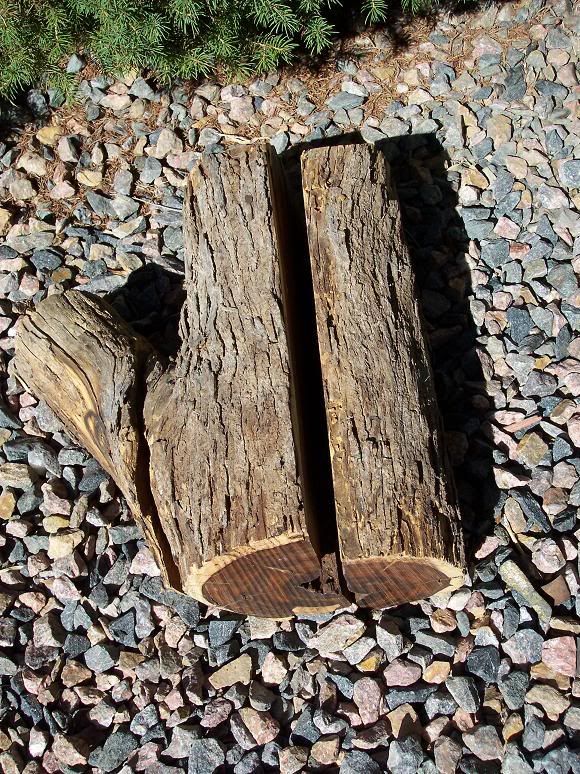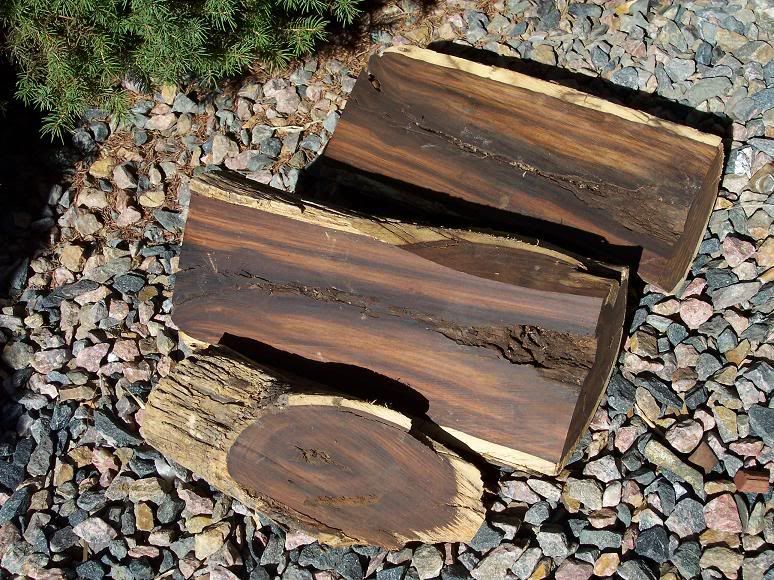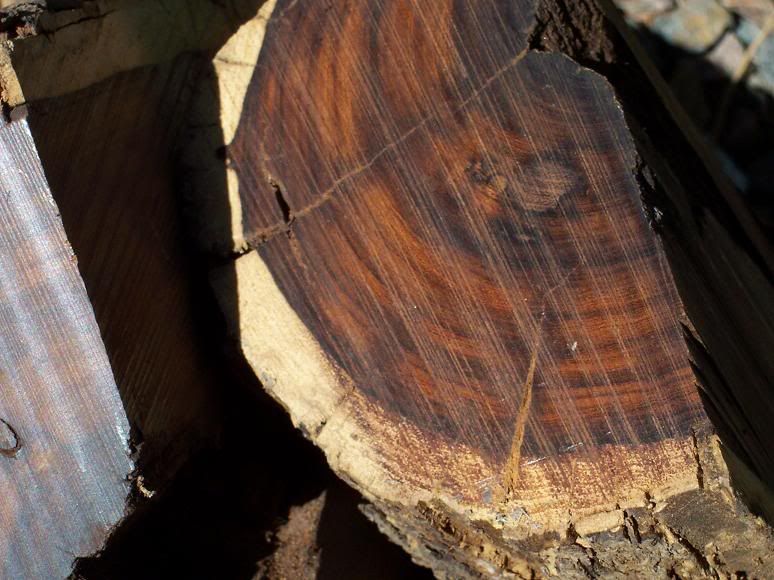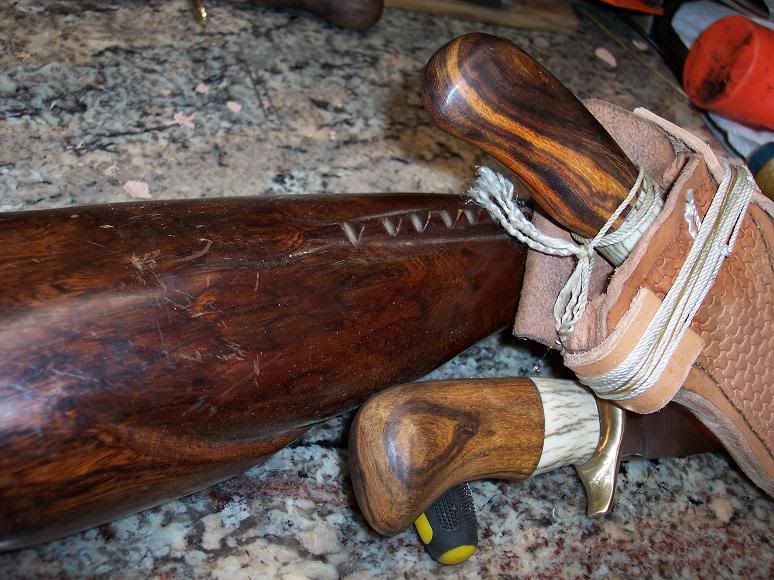You are using an out of date browser. It may not display this or other websites correctly.
You should upgrade or use an alternative browser.
You should upgrade or use an alternative browser.
burning hedge.
- Thread starter woodcutter69
- Start date

Help Support Arborist Forum:
This site may earn a commission from merchant affiliate
links, including eBay, Amazon, and others.
I can't afford the shipping cost. The stuff is like a block of stone, except it's covered in thorns. The female drops an unedible green fruit that averages about the size of a big orange and probably weighs more (hedge apples). The male produces no fruit, only sharp thorns and leaves. Some thorns reach a length of two inches and thus farmers have been known to cut them off with pocket knives and use them as tooth pics. That includes me.Would someone in Hedge territory PLEASE UPS me an armful of this mythical wood you all talk about???!! I'd like to see what all the hub-bub is about.
Farmers often planted them to make hedges to define their land and make wind breaks. It grows thick and nobody wants to walk through the thorny branches, not even livestock. The osage orange probably does not know whether it's a tree or a big bush. A mature specimen reaches a height of 50 feet with an equal crown spread. Very slow growing, some hedge rows could easily be over 150 years old. Straight grain is nowhere.
I once hung a pair of still rings from one of the branches in my younger gymnnastic days. When I leaped on the rings for a grab, the branch hardly moved. I don't see how the birds even build nests in it, but they do.
That's mind boggling. Hedge (osage orange) is considered by many to be the densest wood in the USA, even denser than shagbark hickory and about the same as live oak, according to all the books that I have read.
Can you provide a source so that I can study desert ironwood? Even if "half" is an exaggeration, if it is denser than hedge, I would like to read up on it. If so, I would also have to wonder why it has not been sold as an exotic.
TIA.
Denser than Hedge or Desert Ironwood in the USA - Krugiodendron ferreum (leadwood) a specific gravity between 1.34 and 1.42, making it probably the densest wood in the United States.
"Probably" is not needed in the above sentence. Thanks, Ray.Denser than Hedge or Desert Ironwood in the USA - Krugiodendron ferreum (leadwood) a specific gravity between 1.34 and 1.42, making it probably the densest wood in the United States.
Here's an interesting observation. Take a strip of ordinary white ash about 6" long and 1/16" thick. Submerge it temporarily into a pail of water and then let it float. Come back the next day or so. The strip will have sunk to the bottom of the pail.
Common red oak, white oak, or hickory that are all denser might might do the same, but I'm not sure.
sawinredneck
Addicted to ArboristSite
Other than getting the fore started, I ONLY burn Hedge. BUT that is in an airtight stove. I don't reccomend burning this in anything else, and even then you have to watch when you get some air on it. It pops more than you can imagine!!!
Green, it can gut like butter, or like a rock! I've cut both!! Seasoned, just go rent a concrete saw!! Yeah, it's really that hard!! I have had sparks come off of GREEN wood!
I don't know about density, nor do I care. I just know pound for pound, I can't get more heat from anything than Hedge, just don't overload the fire box!!!!
I like it about 95deg. in the living room when it's around 10 deg. outside. That keeps thebedroom at 75
Green, it can gut like butter, or like a rock! I've cut both!! Seasoned, just go rent a concrete saw!! Yeah, it's really that hard!! I have had sparks come off of GREEN wood!
I don't know about density, nor do I care. I just know pound for pound, I can't get more heat from anything than Hedge, just don't overload the fire box!!!!
I like it about 95deg. in the living room when it's around 10 deg. outside. That keeps thebedroom at 75
Hedge also goes by the name "bois d'arc'. The indians sought it above all others for their bows.You can hear the name 'bodark in many places.
btlook1
ArboristSite Lurker
Would someone in Hedge territory PLEASE UPS me an armful of this mythical wood you all talk about???!! I'd like to see what all the hub-bub is about.
Send me a box to put it in and a pre-paid thing I can sure drop some off. Do you want seasoned or green? Hedge sucks cutting sometimes but it's the best. We use it for corner posts on our fences out here in Ks. You can put a good corner in and it will still be holding wire up 20yrs later. Quite a few people make good $$ cutting posts. I usually see a semi load or two every week all winter long headed west.
pacman
ArboristSite Operative
Hedge is ever where around here, nobody touches really.
sawinredneck
Addicted to ArboristSite
Hedge is ever where around here, nobody touches really.
Must not get that cold there!
pacman
ArboristSite Operative
A bad winter is 10 -15 degrees mostly around the 30-40 Tenessee.If it snows here its gone the next day.
KsWoodsMan
Addicted to ArboristSite
+1! Mulberry, when cut alive, is yellow green. When it seasons, it turns deep burnt orange, starting with the log ends. Hedge is much denser than Mulberry when dry and I have never seen a Mulberry tree with big thorns.
I burn about 1 to 3 cords of Mulberry a year. My only complaint is the sparks that it throws while burning, even when burned dry. Sure, it burns hot, but those sparks can be dangerous. And, if you want to hand split it, be prepared for a workout. Mulberry is snarly wood.
Both woods will season to nearly black as the wood oxidizes. Mullberry has less of the Orange cast or hue to the wood and more sapwood. I dont remember saying I easily mistake them and hope it wasn't for my benefit.
Are you sure about it being hard to hand split? Both species are straight grained and split easily by hand from butt to stem.
ShoerFast
Tree Freak
- Joined
- Nov 14, 2005
- Messages
- 25,843
- Reaction score
- 17,230
Just as a comparison for denseness, here are a couple pictures of Desert Ironwood. This 15" block weights 18#'s



And a picture of some DI burl and knife handles, Hedge would save some weight, but we seem mixed on how much? But would be worth a try, as I hear about it, but never worked with it!




And a picture of some DI burl and knife handles, Hedge would save some weight, but we seem mixed on how much? But would be worth a try, as I hear about it, but never worked with it!

KsWoodsMan
Addicted to ArboristSite
I think you just gave me the outline for a Blues song! You burned me, baby,stay outta my hedge!
Run with it ! according to her, she could really build a fire. LOL She broke my heart but I've got good wood again.
Mulberry is easy to split on some limbs and a gorilla on others. It varies as you move along the tree because this tree grows crooked branches in every which direction, much like a bush, and crotchwood is everywhere. You also run into embedded knots that the tree grows around and hides all the time. The larger specimens are notorious for this.Both woods will season to nearly black as the wood oxidizes. Mullberry has less of the Orange cast or hue to the wood and more sapwood. I dont remember saying I easily mistake them and hope it wasn't for my benefit.
Are you sure about it being hard to hand split? Both species are straight grained and split easily by hand from butt to stem.
Regardless, burning mulberry is worth the effort of you don't mind the sparks. Just be careful when opening the loading door to add more wood. The sudden rush of air sets off the sparking.
Run with it ! according to her, she could really build a fire. LOL She broke my heart but I've got good wood again.
sometimes ya gotta leave the gnarly old crotch and find one with straighter grain...
KsWoodsMan
Addicted to ArboristSite
Too funny !sometimes ya gotta leave the gnarly old crotch and find one with straighter grain...
I can see this one going downhill pretty quick. Let's just say the new one has more even spacing in the growth rings and better burls.
Yip Hedge burns hot. If you are used to lesser wood it will surprise you.
I'll resist the downhill slide. Speaking of Hedge, I fell into a great deal through a friend.His buddy has over 100 acres, mostly Hedge and Oak, that was tore up by an ice storm...3 or 4 years ago! He said we can have all we want, and he'll even help with his tree shear.Yes, Virginia, there is a Santa Claus...
urhstry
ArboristSite Operative
In what areas does that desert ironwood grow? Southeastern US? I've never seen or heard of it before. Nice looking wood.
ShoerFast
Tree Freak
- Joined
- Nov 14, 2005
- Messages
- 25,843
- Reaction score
- 17,230
In what areas does that desert ironwood grow? Southeastern US? I've never seen or heard of it before. Nice looking wood.
It is rare.
Thanks!
Desert Ironwood comes from the Senora Desert, (and Mexico) I have one firewood sized block that is estimated at about 1500 years old!
KsWoodsMan
Addicted to ArboristSite
Do you mean that one piece took 1500 years to get to that size ? or the tree died 1500 years ago and has yet to deteriorate ?
I tried to blow up one of the pictures a bit and had trouble seeing the annular rings. I would readily think it took that long to grow. Something that seems interestijng is the 7-8 lighter bands in the heartwood. As if the desert where it came from was wetter in those years. The last couple hundred years of the heartwood shows to be very dark. The first few hundred years could be dark just from age but makes me wonder if it might have been covered in ice part or most of its growing sesson. I might haver it backwards too. That the area it came from was a greener tropical enviroment when it was a sprout. Either way it is a great looking wood and shouldnt go in the firebox.
It would be interesting to get some seeds to germinate and see if it does any better in a moister climate. I can think of a spot in my yard (hint hint) that gets regular sun.
I tried to blow up one of the pictures a bit and had trouble seeing the annular rings. I would readily think it took that long to grow. Something that seems interestijng is the 7-8 lighter bands in the heartwood. As if the desert where it came from was wetter in those years. The last couple hundred years of the heartwood shows to be very dark. The first few hundred years could be dark just from age but makes me wonder if it might have been covered in ice part or most of its growing sesson. I might haver it backwards too. That the area it came from was a greener tropical enviroment when it was a sprout. Either way it is a great looking wood and shouldnt go in the firebox.
It would be interesting to get some seeds to germinate and see if it does any better in a moister climate. I can think of a spot in my yard (hint hint) that gets regular sun.
Similar threads
- Replies
- 9
- Views
- 715
- Replies
- 35
- Views
- 2K
- Replies
- 17
- Views
- 2K
- Replies
- 5
- Views
- 660



